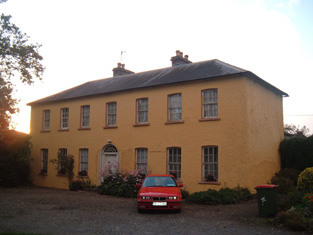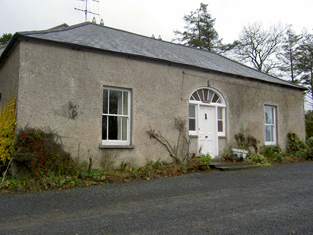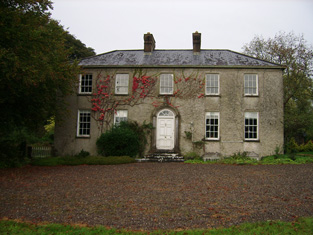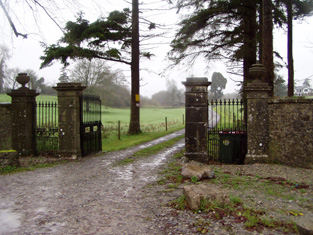Clogheen
Houses within 5km of this house
Displaying 20 houses.
Houses within 5km of Clogheen
Displaying 20 houses.
| House name | Description | |
|---|---|---|
| Rathclare | Clare Cottage was originally a residence on the Egmont estate which Hajba writes was leased to the Norcott family. Occupied by Martha Bullen in the early 1850s when the house was valued at £13. A much larger house was constructed in the mid 19th century incorporating the original building. By the end of the 19th century the home of the Burdon family who were still resident in 2002. In 2012 it was being offered for sale. |

|
| Ardenville | A single storey house possibly built for the heir to the Egmont title, Baron Arden, to reside in before succeeding to the title. At the time of Griffith's Valuation it was occupied by James Norcott and valued at £11.10 shillings. Recently extended and still occupied. | |
| Spitalfields | Dating from the mid 18th century, Hajba writes that this house was built by Christopher Waggett, nephew and son-in-law of George Crofts of Velvetstown House. By 1814 it was occupied by Richard Purcell and at the time of Griffith's Valuation by Fitzgerald O'Keeffe who held it from the Earl of Egmont. It was valued at £20+ at this time. In the 1870s George Crofts Harris of Spittalfields owned 591 acres in county Cork. The property of the O'Brien family in the 20th century, run as a guest house. |

|
| Buttevant Castle | Originally a castle of the Barry family, Earls of Barrymore, sold by them in the early 19th century to John Anderson of Fermoy, who restored it as a castellated house and gave it to his eldest son Sir James Anderson. Sir James lived there until the mid 1840s. William Roche occupied the building valued at £37 in the early 1850s. He held the property from Viscount Doneraile and D.R. Browning held a house, flour mill and offices valued at £120 from Roche. The castle had various occupants in the later 19th century and was last occupied in the early 20th century. It is now a ruin. |

|
| Castle View | Located on the Doneraile estate in the mid 19th century this house was occupied by Barry Gregg in 1837 and by the Reverend Cornelius Burkley in the early 1850s when it was valued at £28. This 18th century seven bay house is still a family residence. |

|
| Springfield | The seat of the Norcott family in the 18th and 19th centuries, occupied by Hugh Norcott in 1814 and by James Norcott at the time of Griffith's Valuation when the buildings were valued at £18. The property was held from the Viscount Doneraile at this time. Sold to the Davisons in 1908, it remained in their possession for much of the 20th century. The house is still occupied. |

|
| Doneraile Court | A house of mainly early 18th century origin with 19th century additions located beside the village of Doneraile. Wilson, writing in 1786, describes it as "the magnificent and beautiful mansion, with extensive parks, gardens and demesnes". At the time of Griffith's Valuation the house was valued at £140. In 1942 the Irish Tourist Association Survey stated that the property had been bought by William St. Leger from Sir Walter Welmond and John Spenser, sonf of the poet Edmund Spenser. It was unoccupied in the 1940s and the agent was Mr. Hamilton. The house was sold to the Land Commission in 1969 by the wife of the 7th Viscount. The building was first restored by the Irish Georgian Society and since the early 1990s by various State bodies. It and the 400 acre demesne are now under the care of the Office of Public Works. |

|
| Springfort Hall | A branch of the Foott family were resident at Springfort from the early 18th century. The house was occupied by James Foot in 1814 and by [his grandson] another James Foote in the early 1850s, who held the property from the Earl of Limerick. Hajba writes that Springfort Hall was bought by Charles W. Wyatt in 1854 and sold again four years later to Captain Spencer Stewart, a grandson of the 7th Earl of Galloway. Springfort remained in the possession of the Stewart family until the beginning of the 20th century. It was leased to Commander Hans Thomas Fell White in 1895. It now functions as a country house hotel. |

|
| Elmvale | Elmvale was occupied in 1814 by Henry Lysaght and by 1837 was in the occupation of J. Duggan. Arthur Duggan held the property from the Earl of Limerick in the early 1850s. The house was valued at £20. Hajba writes that in the early 20th century the house was purchased by Sidney Royse Lysaght and following a feud with a neighbour was burnt in 1917. Later rebuilt and still occupied. |

|
| Pencil Hill | This house was built in the 1780s by Harmer Spratt who had married a member of the Foott family. It was known as Monte Video in 1837. The Spratt continued to live in the house untill the early 20th century when it was sold to the Perrott family. The Perrotts changed the name of the house to Beechfield and it was still the home of this family at the beginning of the 21st century. | |
| Hazlewood | ''Burke's Irish Family Records'' suggests that this was originally an Atkins property which came into the possession of the Lysaghts through marriage. Hajba writes that William Lysaght built the house following his marriage in 1819 to Frances Atkins. Colonel Grove White's notes state that it was built before the marriage. In 1837 it was occupied by William Lysaght and in the early 1850s by Carbery B. Egan who held the property from William H. Lysaght. The buildings were valued at £21. This house remained in Lysaght posssession throughout the 20th century having been sold in 1913 by William Lysaght to his first cousin, Sidney Royse Lysaght. In the 1940s the Irish Tourist Association Survey noted that it was famous for its plant nurseries. |

|
| Kilburn/Kilbyrne | The White family resided at Kilburn from the early 18th century to the mid 20th century. The original building was replaced by a new house built in the late 1820s. This building was valued at £35 in the early 1850s. From 1903 to 1938 this house was the home of Colonel James Grove White who compiled the work ''Historical and Topographical Notes on Buttevant, Castletownroche, Doneraile and Mallow.'' The house was partly demolished in the mid 20th century. | |
| The Hermitage | Hajba states that this single storey house was built by the Reverend John Bagwell Creagh before 1814. Located on the Creagh estate it was occupied by J. Norcott in 1837 and by Samuel Morton Tuckey in the early 1850s, when the buildings were valued at £15.10 shillings. Later inhabitants included William Stawell. Home of the Broderick family in the 20th century. |

|
| Kilbrack | Hajba writes that this house was built by William Stawell who married Catherine Creagh of Creagh Castle. William was succeeded by his nephew the Reverend Francis Stawell in 1830. Kilbrack remained in Stawell possession until the end of the 19th century. It is still a family home. |

|
| Ballyellis | Ballyellis was occupied by Edmund Barry in 1814 and by Henry Langley at the time of Griffith's Valuation. H. Langley held the property from James Barry and the buildings were valued at £12. It later came into the possession of the Harold Barry family and members of the family were still resident at Ballyellis at the beginning of the 21st century. |

|
| Byblox | Burke's Landed Gentry of Ireland (1904) traces the Ross family of Dunmoyle from the Mann family of Byblox in the first half of the 18th century. Hajba writes that the original house was occupied by the Langley family in the 18th century. At the end of that century Roger Langley leased Byblox to Robert Fennel Crone who built a new house to replace the original which had been accidentally burnt. It was valued at £70 in the mid 19th century. The descendants of Robert F. Crone, including members of the Croker family, inhabited this six bay, three-storied house until the beginning of the 20th century when it was bought by the Morrogh Bernards. In the 1940s the Irish Tourist Association Survey noted that the house was then in the possession of Mrs. Drake Brockman but it was unoccupied with John Roche acting as agent. Byblox was demolished in the 1960s. |

|
| Old Court (Doneraile) | Originally a Watkins house, the property was leased to Jonas Stawell in 1813. The Stawells built a new house circa 1814. The Watkins sale rental of June 1853 includes a lithograph of the house and floor plans. In the early 1850s George C. Stawell held the house, valued at £40, from Edmund Nagle. Sold in the early 1850s to the Morroghs of Glanmire House. In the 1940s the Irish Tourist Association Survey noted that this property had also been associated with Alexander Roche, the brother of Lord Fermoy. At the time of the survey the house was occupied by a Miss Creagh and a Miss Shannon. It is now a ruin. |

|
| Saffron Hill Cottage | Hajba writes that this house was built in the first decade of the 18th century by Reverend Edward Sayers, rector of Templeroan. An Edmund Sayers is recorded as the occupant in the early 1850s. He held the property from Viscount Doneraile. The buildings were valued at £22. The Sayers estate at Croghnacree was advertised for sale in November 1859, November 1864 and May 1865. In 1906 Lord Castletown was recorded as the occupier. This house, an eleven bay single storey building, ceased to be a residence in the mid 20th century but has since been restored and is now inhabited again. Reference to the Sayers family in the Moore sale rental of 27 Feb 1863. This house is also associated with the Brasier Creagh family. |

|
| Rough Hill | The home of the Harmon family from the late 18th to the late 19th century. At the time of Griffith's Valuation Samuel Harman occupied the house valued at £12 and held from Sampson French. Buildings are still extant at the site. | |
| Cahermee | A late 17th century house belonging to the Freeman family, passed by marriage to the Hewson family. A Hewson relative John Milward was resident in 1814. Occupied by John Kearney and held from John Hewson at the time of Griffith's Valuation, when the buildings were valued at £8.5 shillings. Hajba writes that Margaret, daughter of William Hewson Kearney, inherited the house and she married Michael Carroll. This house is no longer occupied. |

|

